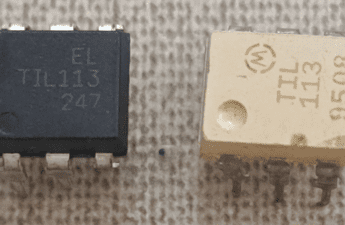This is the second part about BJT polarization. Are shown projects of circuits with fixed and emitter’s stable polarization.
If you aren’t from the field, I suggest to read the operation of BJT transistor and part 1 about this component’s polarization first.
Link to BJT operationClick here
Link to part 1 of BJT polarizationClick here
BJT fixed polarization
This is an example of fixed polarization circuit with NPN transistor. Emitter terminal is linked to ground.

Considering these information:
- Base current (I_{b}): 20 μA.
- Emitter current (I_{e}): 4 mA.
- Voltage between colector and emitter (V_{CE}): 7.2 V.
We have to find these information:
- Colector current (I_{c}).
- Beta (β).
- Supply voltage (V_{CC}).
- Base resistor (R_{b}).
Calculating I_{c}.
I_{e}=I_{c}+I_{b}
I_{c}=4000\mu -20\mu = 3980\mu =3.98mA
Finding out supply voltage V_{CC}.
I_{c}=\frac{V_{CC}-V_{CE}}{R_{c}}
3.98m=\frac{V_{CC}-7.2}{2.2k}
V_{CC}=15.956 V
Finding β and R_{b}.
I_{c}=\beta \cdot I_{b}
\beta= \frac{3.98m}{20\mu }=199
R_{b}= \frac{V_{CC}-V_{BE}}{I_{b}}
Considering V_{BE} as 0.7 V.
R_{b}= \frac{15.956-0.7}{20\mu }=762 k\Omega
Designing current sources with fixed polarization
This is a current source project with a NPN BD139 transistor, whose datasheet is in this link. Voltage supply is 6 Volts, while current colector must be 100 mA. Transistor must be in saturation state.

Looking at datasheet, you can see that in saturation state, voltage V_{CE} is 0.5 V.

Calculating R_{c}.
R_{c}=\frac{V_{CC}-V_{CE}}{I_{c}}=\frac{6-0.5}{0.1}=55\Omega
Collector’s resistor will dissipate sizeble power, therefore, must have a size bigger than 1/4 W resistors to avoid burn. The chosen commercial value is 47 Ω, because it was the closest I had with enough size to stand electric current.

To calculate base current I_{b}, current gain h_{FE} or β was considered 25.
I_{b}=\frac{I_{c}}{h_{FE}}=\frac{0.1}{25}=4mA
Determining value of R_{b}.
R_{b}=\frac{V_{CC}-V_{BE}}{I_{b}}=\frac{6-1}{4m}=1.25k\Omega
Commercial value of R_{b} is 1.2 kΩ.

What if use a PNP transistor like BD136? Just invert DC source’s poles, emitter must be connected to positive pole.

This is another fixed polarization project, collector current was arbitrarily chosen as 150 mA. While gain, h_{FE} or \beta, is 40.

Calculating Rc.
Rc=\frac{V_{CC}-V_{CE}sat}{I_{C}}=\frac{6-0.5}{150m}=36\Omega
Finding Rb’s value. Parameters in the datasheet are negative, but since poles were exchanged, you can consider these values as positives.
I_{b}=\frac{0,15}{40}=3,75mA
R_{b}=\frac{5}{3,75m}=1,33k\Omega
The chosen commercial values for R_{c} and R_{b} are 30 Ω and 1,2 kΩ respectively. The value of I_{c} can vary between 149 and 155 mA.
Stable emitter polarization

A resistor between emitter terminal and ground improves circuit’s stability. Mathematically demonstrating using two following circuits as examples.

Calculating collector current I_{c} and colector-emitter voltage V_{CE} of T1 circuit, we have calculated values below. You can confirm considering base-emitter voltage V_{BE} as 0.7 V.
I_{c1}=2.925mA
V_{CE1}=8.089V
If T1’s β is 135, values are:
I_{c2}=4,38mA
V_{CE2}=4,174V
Calculating the percentage of parameters’ variation using the following equations.
%\Delta I_{c}=\left |\frac{I_{c}2-I_{c}1}{I_{c}1}\right |\cdot 100%
%\Delta V_{CE}=\left |\frac{V_{CE}2-V_{CE}1}{V_{CE}1}\right |\cdot 100%
Results are respectively 49.4% and 48.3%. Now, calculating the same parameters in T2 circuit. This equation can be used to find base current in emitter’s stable polarization circuit. R3 is emitter’s resistor. While V_{BE} is 0.7 V.
I_{b}=\frac{V_{CC}-V_{BE}}{R_{b2}+(\beta +1)\cdot R3}
Results are:
I_{c}=2.9 mA
V_{CE}=8.6465V
What if T2’s β is increased to 150?
I_{c}=3.9mA
V_{CE}=4.75V
Using percentage equations shown before.
%\Delta I_{c}=\left | \frac{3.9m-2.9m}{2.9m}\right |\cdot 100=34.4%
%\Delta V_{CE}=\left | \frac{4.75-8.647}{8.647}\right |\cdot 100=45%
T2 circuit is more stable, because collector current and collector-emitter voltage vary less when β increases 50%.
One more project

This is circuit project with a stabilizer resistor. Transistor used is BC547B, supply voltage V_{CC} is 6 V and collector current must be 20 mA. Looking at this graphic from datasheet, you can see that current base can be 0.15 mA when V_{CE} is 0.2 V.

Using equation to find out values of R_{b} and R_{e}. β is:
\beta =\frac{20m}{0.15m}=133.3
Defining R_{b} and R_{e}.
I_{b}=\frac{V_{CC}-V_{BE}}{R_{b}+(\beta +1)\cdot R_{e}}
0.15m=\frac{6-0.7}{R_{b}+(133.3 +1)\cdot R_{e}}
0.15m\cdot R_{b}+20.145m\cdot R_{e}=5.3
The value chosen arbitrarily for R_{b} was 2.7 kΩ.
0.405+20.145m\cdot R_{e}=5.3
R_{e}=242\Omega
The commercial value of R_{e} is 220 Ω. Since emitter current is the sum of I_{b} and I_{c}, it’s value is 20.15 mA. Calculating emitter’s voltage.
V_{e}=220\cdot 20.15m=4.433V
Discovering voltage drop in R_{c}.

V_{c}=6-(V_{CE}-V_{e})=6-(0,2+4,433)=1,367V
R_{c}=\frac{1,367}{20m}=0,06835k=68,35\Omega
Fortunately, I have a 68 Ω resistor. Finally, assembling the circuit in a protoboard and making measurements.

Current value I_{c} shown above aren’t exactly 20 mA. Because resistors have tolerance, causing a small variation in resistance.
Other parts about projects with BJT transistors will come.



